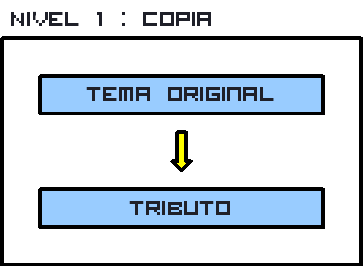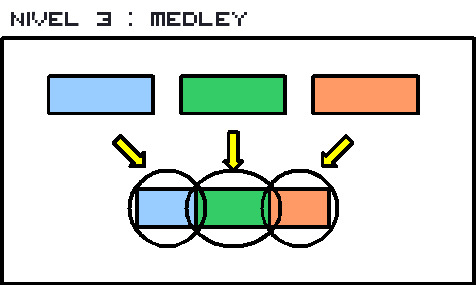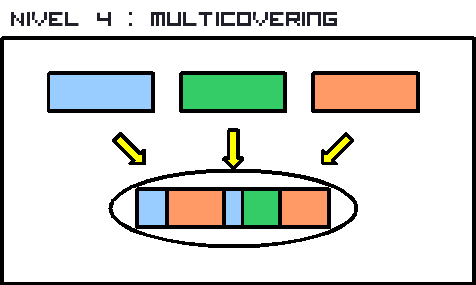
Multi-covering
Music is, with videogames, my two favorite arts. But there is something quite annoying in videogames: the boring parts. In videogames, sometimes you have to pass 500 very boring turn based combats to have a bit of interesting gameplay (I’m looking at you, Final Fantasy). Part of the boredom is unavoidable, like playing the tutorials to learn the stuff, but any extra boredom is just a lack of design.
In music we face a similar problem, but it’s even more difficult to fix. I’ll try to explain it as simple as possible, like I were an dummy in music theory (which is not very far from truth):
Most of the current popular music its based on a quite fixed model: intro-verse-bridge-chorus-loop-solo-main twice (sometimes with modulation)-end. The model itself is not bad, because the own definition of popular music force the music structure to be simple and familiar. The problem is that most of these parts usually have very low musical value. The artists focus their energies in make good choruses and the rest of the song is just to decorate. So we have to wait for a minute (the usual time the chorus to appear) to start enjoying, then wait for a while until the good comes. Many times, the rest of the elements not only a surplus, but they hinder. Sometimes they are cool, but most of the time the verses are musically boring as hell (and very often the lyrics too), the guitar solos are just a pirupiru up and pirupiru down and so on. At the end, from an album you can rescue about 1 minute and a half of pure musical value. With luck.
And I say it’s a no-solution problem for two reasons. First, because many of the music producers and consumers don’t consider it a problem at all. They think all the parts are important, like the silent moments in an action movie. And second, because is quite rare to find an artist or band so good and creative to create 60 minutes of excel music per year. Yes, we know some albums that are great from the beginning to the end, but not so many, and usual isolations in an artist career. But the covers arrangers don’t have that problem: we have a great source of pure quality material that we can exploit in much better ways than just copying a song with all the trash it comes with; it’s very difficult to surpass the original like this.
Before explaining how to do that, let’s make a brief about the covering process.
I suppose I don’t need to say that covering is making an interpretation from a musical track, usually famous. Even when this page are about metal covers from videogame tunes, this theory could be applied to any style.
And to talk about this (arguably) innovation this band is proposing, I’ll divide this field into 4 levels of the art of covering.
Covering level 1
The first level, the most common, is to play the song as exact as possible, respecting the original style aswell. This kind of covering is targeted to nostalgic or fans of the original band. This level can also be called Tribute.
The cover’s autorship is quite low. If you are hired to play Beatles in a wedding, maybe the drunk public will not be delighted if you add a neoclassical touch to “I Want to Hold Your Hand”.
Covering level 2
The adaptation or arrangement is to cover the song into a new style. Usually 2 elements are at stake: a generational step, leading the artist to modify a previous theme for adjusting it to common likes, or a boast of artist’s creativity (sometimes simply an ego excess, but I didn’t told that). This is the ground of Game Metal (the genre of the band this page is based on, in the case you came to this page from other places).
Sometimes this level is called Revival, specially when there are some generations between the original song and the cover. It could mean renaissance, but I prefer to keep it as Revival to avoid misconception with the artistic period and because it sound cooler.
The cover’s autorship is low. Sometimes the revival could be quite interesting, but most of the time it’s just an standard adaptation to the new style, and can be applied to a Vivaldi sonata and to Sesame Street’s main theme.
Covering level 3
A more evolved cover is to take several songs and mix them into one. The famous medley.
Its main problem is that it’s like playing several songs, but “glued”. The musical unity is lost (represented in the graphic with circles). And if the parts doesn’t fit well, the result is musically inferior than previous levels.
Cover’s autorship: Medium if done well. Very low if not. Generally this kind of cover is done by the bands themselves when the TV time is limited.
A level 3.5 would be a mix between Medley and Revival, a medley in another style. It’s not interesting enough to have an extra pic, neither innovative enough to have its own level. But, ok, he can have his own name, Medlevival.
Versión de Nivel 4
Medlevival was angry for being insultated in the last point, so he went to the nearest dungeon to kill rats, leveling up and becoming… Multicovering!! Let’s explain it in detail:
- Select several songs with similar style and tempo. It’s not necessary to take all the song, just a part with enough musical quality.
- Insert that part in the new song, performing the same or different function in the song structure. If the samples collected were single melodies or chorus, in the new song they can have another funtion: intro, bridge, solo…
- The new song is designed and composed based on the combination of functions of point 2. It could be something standard such as intro-verse-chorus-andthelike or something more complex and creative.
- The new parts are assembled and adapted to sound like an unity, like modifiing templo, tone, modulations, composing transitions, etc.
- Continue with the common musical process: add lyrics, record, mix, master, whatever.
Final result is (or would be) a song of high musical richness which sounds like an unity, in a way that somebody who doesn’t know the orignal parts doesn’t detect the multicovering.
In fact, this is the goal of every cover, regardless the level: it doesn’t have to sound like a cover. It has to be so complete that has musical value regardless the original song(s). Even surpass them. The higher the covering level, the more difficult it becomes, but also higher is its merit, quality and, maybe, its reach.
Let’s put a simple example: the main theme of The Legend of Zelda (the original, NES version), that we multicover it with the name “Enter Our World”. 3 parts: intro, A and B. The intro is an standard, simple one. “A” part is awesome, one of the most famous and beloved themes in videogames music history. The B part is really bad, but the people is used to it so everybody covers it too. We repeat A part and blend it with an R-Type song. This is the most simple multicover we use, but it’s enough for you to ponder if it makes the theme great, or if we deserved to be burned for such profanation.
Anyway, in Game Gods we will use multicovering in a basic form in the level 1 songs, but more ellaborated in the level 2 ones.

Multicovering by Game Gods is licensed under a Creative Commons Reconocimiento 3.0 Unported License.
Based on a work at gamegods.es.
Permissions beyond the scope of this license may be available at http://gamegods.es/vision/licensing.





 ¡Email general! (Para contrataciones y/o pactos infernales).
¡Email general! (Para contrataciones y/o pactos infernales). ¡Game Gods en ReverbNation!
¡Game Gods en ReverbNation! ¡Game Gods en Tuenti!
¡Game Gods en Tuenti!